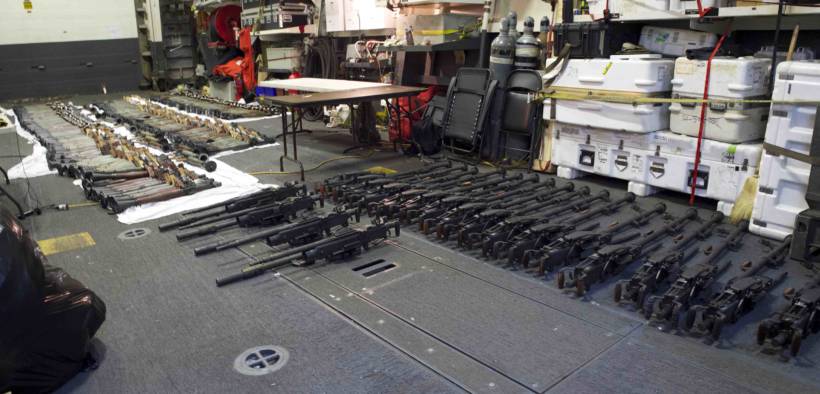US Says it Seized Iranian-Origin Missiles Bound for Yemen Houthi Rebels

In late November, U.S. navy personnel boarded an unmarked ship and found a cache of missile parts that the U.S. claims are Iranian made and bound for Houthi rebels in Yemen.
U.S. naval forces in the Arabian Gulf seized guided missile parts bound for Houthi rebels in Yemen that the U.S. claims were Iranian in origin. The USS Forrest Sherman first stopped and boarded an unmarked small boat on November 25 and seized “advanced missile components” on a stateless ship, according to a Pentagon statement on Wednesday.
Speaking on condition of anonymity to the Associated Press, U.S. officials said that U.S. Navy personnel boarded a small boat and subsequently found the missile parts. The officials added that initial information suggested the missile parts were bound for the Iran-linked Houthi insurgents in Yemen and the boat’s crew was taken to the Yemen Coast Guard.
Not the First Time
Over the past few years, U.S. warships have promptly intercepted Iranian arms shipments, believed to be bound for the Houthi rebels. But Thursday’s incident is said to be different in terms of the nature of the missile parts, the U.S. officials told Al Jazeera.
Iran, according to a United Nations resolution, is prohibited from selling, transferring or supplying any arms outside the country without the United Nations Security Council approval. Also, a separate U.N. resolution concerning war-torn Yemen prohibits supplying weapons to the Houthi group.
Tensions between the U.S. and Iran in the Middle East have risen since the U.S. pulled out of the Iran Nuclear Deal under U.S. President Trump. After a series of attacks and seizures on oil tankers in the Gulf, the U.S. accused Iran of being behind an attack on Saudi oil facilities in September. Since May of this year, around 14,000 U.S. troops have been stationed in the region to counter any Iranian actions.
Earlier Accusations
The U.S. has repeatedly accused Iran of funneling weapons to the Houthi rebels and, according to the Associated Press, on four occasions between 2015 and 2016 seized suspected shipments of Iranian weapons. Former U.S. ambassador to the United Nations Nikki Haley pointed two years ago to a display of seized missile remnants declaring that U.S. intelligence experts concluded “unequivocally” that the weapons originated in Iran. While U.S. officials couldn’t verify whether the weapons were delivered to the Houthis by Iran, the officials and experts believed that the characteristic features of those weapons indicated they were manufactured in Iran. However, U.S. made weapons have also turned up in unintended places like the hands of al Qaeda-linked fighters, hardline Salafi militias, and other factions waging war in Yemen.
A part of the seized weapons showed the logo Shahid Bakeri Industrial Group, which is an Iranian defense establishment that has been subject to U.S.-imposed sanctions and embargo. Although Washington has accused Tehran of supplying the Houthis with such weapons, Tehran has vehemently denied any linkage, describing the accusations as “fake and fabricated.”
Root Causes of Yemen War
Fighting in Yemen began in late 2014 when Houthi rebels took control of large parts of the country, including the capital Sana’a. Mass protests and the Houthi rebel group forced the internationally recognized government of President Abd Rabbuh Mansur Hadi from power in 2015. Since then, Hadi has resided in Riyadh, Saudi Arabia.
The civil war has its roots in the 2011 Arab Spring, which led to a 2011 Yemen uprising that eventually forced the end of the 32-year-long regime of Yemen’s late president, Ali Abdullah Saleh. The uprising grew into a military conflict in 2014 and has since caused the deaths of thousands of people and the displacement of hundreds of thousands more.
Since 2014 the separatist Houthis have engaged in a civil war with the government. In support of the government, Saudi Arabia leads an Arab military coalition, which includes the United Arab Emirates. The Houthis have constantly attacked Saudi Arabia. Most recently, the Houthis allegedly launched missiles and explosives-laden drones against the Saudi oil refinery, Aramco.















